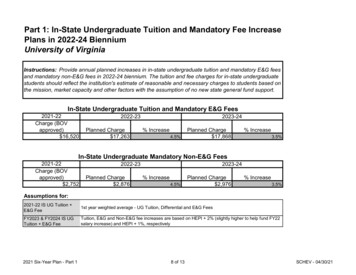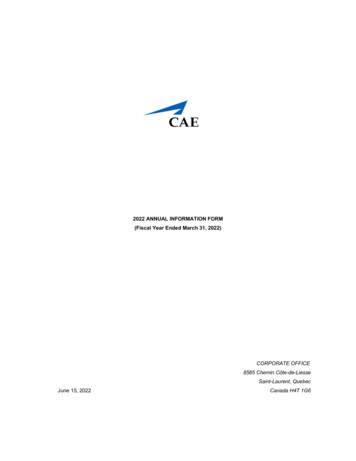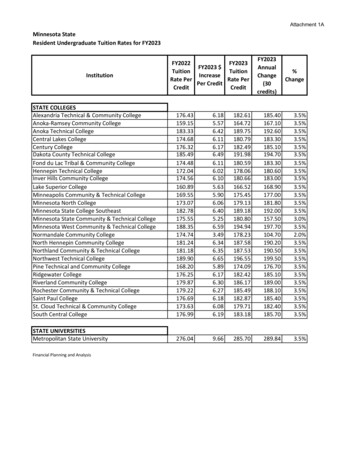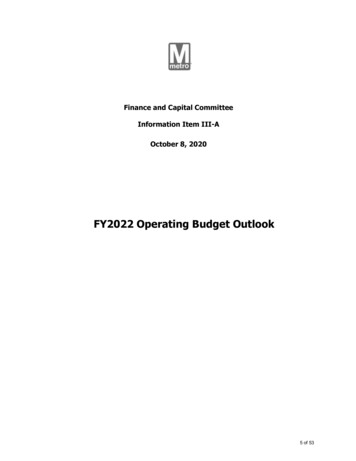
Transcription
FINANCIAL UPDATE Q2 FY2022 // July 2022
Safe harbor statementThis presentation includes express and implied “forward-looking statements” within the meaning of the Private Securities Litigation Reform Act of 1995. In some cases, you can identify forward-looking statements byterms such as “anticipate,” “believe,” “estimate,” “expect,” “intend,” “may,” “might,” “plan,” “project,” “will,” “would,” “should,” “could,” “can,” “predict,” “potential,” “target,” “explore,” “continue,” or the negative of theseterms, and similar expressions intended to identify forward-looking statements. However, not all forward-looking statements contain these identifying words. These statements may relate to our market size and growthstrategy, our estimated and projected costs, margins, revenue, expenditures and growth rates, our future results of operations or financial condition, our plans and objectives for future operations, growth, initiatives, orstrategies. By their nature, these statements are subject to numerous uncertainties and risks, including factors beyond our control, that could cause actual results, performance or achievement to differ materially andadversely from those anticipated or implied in the statements, including: our future financial performance, including our revenue, cost of revenue, gross profit, operating expenses, ability to generate positive cash flow,and ability to be profitable; our ability to grow at or near historical growth rates; anticipated technology trends, such as the use of and demand for experience management software; our ability to attract and retaincustomers to use our products; our ability to respond to and overcome challenges brought by the COVID-19 pandemic; our ability to attract enterprises and international organizations as customers for our products; ourability to expand our network with content consulting partners, delivery partners, and technology partners; the evolution of technology affecting our products and markets; our ability to introduce new products andenhance existing products and to compete effectively with competitors; our ability to successfully enter into new markets and manage our international expansion; the attraction and retention of qualified employees andkey personnel; our ability to effectively manage our growth and future expenses and maintain our corporate culture; our anticipated investments in sales and marketing and research and development; our ability tomaintain, protect, and enhance our intellectual property rights; our ability to successfully defend litigation brought against us; our ability to maintain data privacy and data security; the sufficiency of our cash and cashequivalents to meet our liquidity needs; our ability to comply with modified or new laws and regulations applying to our business; and our reduced ability to leverage resources at SAP as an independent company fromSAP. Additional risks and uncertainties that could cause actual outcomes and results to differ materially from those contemplated by the forward-looking statements are or will be included under the caption “RiskFactors” and elsewhere in our Annual Report on Form 10-K and Quarterly Reports on Form 10-Q that we file with the Securities and Exchange Commission. Forward-looking statements speak only as of the date thestatements are made and are based on information available to us at the time those statements are made and/or management's good faith belief as of that time with respect to future events. We assume no obligationto update forward-looking statements to reflect events or circumstances after the date they were made, except as required by law.This presentation also contains estimates and other statistical data made by independent parties and by us relating to market size and growth and other data about our industry. This data involves a number ofassumptions and limitations, and you are cautioned not to give undue weight to such estimates. In addition, projections, assumptions, and estimates of our future performance and the future performance of the marketsin which we compete are necessarily subject to a high degree of uncertainty and risk.The trademarks included herein are the property of the owners thereof and are used for reference purposes only. Such use should not be construed as an endorsement of such products or services.To supplement our financial results, which are prepared and presented in accordance with U.S. generally accepted accounting principles (“GAAP”), we use certain non-GAAP financial measures, as described below, tounderstand and evaluate our core operating performance. These non-GAAP financial measures, which may be different than similarly-titled measures used by other companies, are presented to enhance investors’overall understanding of our financial performance and should not be considered a substitute for, or superior to, the financial information prepared and presented in accordance with GAAP. We believe that thesenon-GAAP financial measures provide useful information about our financial performance, enhance the overall understanding of our past performance and future prospects, and allow for greater transparency withrespect to important metrics used by our management for financial and operational decision-making. We are presenting these non-GAAP measures to assist investors in seeing our financial performance using amanagement view, and because we believe that these measures provide an additional tool for investors to use in comparing our core financial performance over multiple periods with other companies in our industry.You should consider non-GAAP results alongside other financial performance measures and results presented in accordance with GAAP. In addition, in evaluating non-GAAP results, you should be aware that in thefuture we will incur expenses such as those that are the subject of adjustments in deriving non-GAAP results and you should not infer from our non-GAAP results that our future results will not be affected by theseexpenses or any unusual or non-recurring items. Non-GAAP gross profit, non-GAAP gross margin, non-GAAP operating income (loss), non-GAAP operating margin, non-GAAP net income (loss), non-GAAP netincome (loss) per share, free cash flow, free cash flow margin: We define these non-GAAP financial measures as the respective GAAP measures, excluding equity and cash settled stock-based compensationexpenses, including employer payroll tax on employee stock transactions, amortization of acquired intangible assets, acquisition related costs, changes in the fair value of our distribution liability for our tax sharingagreement with SAP, and the tax impact of the non-GAAP adjustments, as applicable. When evaluating the performance of our business and making operating plans, we do not consider these items (for example, whenconsidering the impact of equity award grants, we place a greater emphasis on overall stockholder dilution rather than the accounting charges associated with such grants). We believe it is useful to exclude theseexpenses in order to better understand the long-term performance of our core business and to facilitate comparison of our results to those of peer companies and over multiple periods.2
Qualtrics at a glance2020, 2021, and H1’22 Revenue and Revenue Growthin MM5,400 1.8Bnemployees1 41% 42%total revenueYoY growthtotal revenueYoY growth2,146customers with 100Kin annualized recurringrevenue1 51% 49%subscriptionYoY growth 60Bntotal addressablemarket3subscriptionYoY growth126%net retention rate2Remaining PerformanceObligations – 39%YoY Growth12%FY2020FY2021TOTAL REVENUE1–As of June 30, 2022 H1’21H1’22Q2’22 Non-GAAPoperating marginSUBSCRIPTION REVENUE2–As of June 30, 2022 based on Subscription revenue 3–Market sizing based on Qualtrics internal analysis and estimates3
4
5
6
CONTINUED CATEGORY ANDPLATFORM INNOVATION7
Ongoing growth opportunitiesFUTUREFUNCTIONALITYproduct-specific use casesindustry-specific solutionsECOSYSTEMCUSTOMEREXPANSION 2% penetrated inTAM focused onenterprise cross-sellinto existing base1INTERNATIONALcontinued buildoutof partner networkdeepen productintegrations / workflowsSAP partnershipEuropeAPJLATAM81 – As of June 30, 2022
Q2’22 customer wins9
Our customers span across all industries85 2,146 3%OF FORTUNE 1001CUSTOMERS WITH 100K ARR2LARGEST CUSTOMER ASBANKING/INSURANCERETAILTRAVEL & HOSPITALITYGOVERNMENTHEALTHCARE/LIFE L AND MEDIA% OF TOTAL REVENUE3CPG1–Fortune 100 based on 2020 Rankings 2–As of June 30, 2022 3–For the 12 months ending June 30, 202210
Rapidly scaling our global presenceRevenue outside the United States26%28%FY20191FY2020129%FY20211Local sales presence around the ngaporeRaleighVancouverLondonTokyoChicagoSão PauloParisHong KongAtlantaMexico CityStockholmMelbourneD.C.Buenos AiresMadridSeoulNewtonBogotaZurichMumbaiNew YorkSan nd111 – For the year ending December 31
Continued revenue growth at scaleQuarterly Total RevenueQuarterly Subscription Revenuein MM% YoYGrowth38%in MM41%48%41%43%% YoYGrowth48%49%61%50%47%12
Historical remaining performance obligations1in MMNon-Current Remaining Performance ObligationsCurrent Remaining Performance Obligations2YoYGrowth %TotalRPO62%76%39%CurrentRPO25%61%38%1–Remaining performance obligations represent all contracted future revenue that has not yet been recognized, including both deferred revenue and non-cancelable contracted amounts that will be invoiced and recognized as revenue infuture periods2–Defined as RPOs expected to be recognized as revenue in next 12 months13
Growing large customers who still representsmall percentage of overall customer baseNet RetentionCustomers with 100K in Subscription ARRRate1% YoYGrowth38%38%45%41%37%1–Net retention rate is calculated using subscription revenue. We first calculate the subscription revenue in one quarter from a cohort of customers that were customers at the beginning of the same quarter in the prior fiscal year, orcohort customers. We repeat this calculation for each quarter in the trailing four-quarter period. The numerator for net retention rate is the sum of subscription revenue from cohort customers for the four most recent quarters, or numeratorperiod, and the denominator is the sum of subscription revenue from cohort customers for the four quarters preceding the numerator period.14
Steady margins while investing for growthNon-GAAP GrossNon-GAAP OperatingS&MSUBSCRIPTION GROSS MARGINMarginTOTAL GROSS MARGINExpensesas % of Revenue5%Please refer to the Appendix for Non-GAAP to GAAP reconciliation5%R&DG&A0%1%2%15
Guidance summaryQ3 2022Quarterly GuidanceIncrease Y/Y (At Midpoint)Subscription Revenue 303M – 305M38%Total Revenue 358M – 360M32%1.5% – 2.5%(291)bps( 0.02) – ( 0.04)-Non-GAAP Operating MarginNon-GAAP Net Income (Loss) Per ShareAssuming 595Mweighted averageshares outstandingFull-Year 2022Full-Year GuidanceIncrease Y/Y (At Midpoint)Subscription Revenue 1,202M - 1,206M38%Total Revenue 1,422M - 1,426M32%1.5% – 3%(72)Bps( 0.07) – ( 0.09)-Non-GAAP Operating MarginNon-GAAP Net Income Per ShareAssuming 600Mweighted averageshares outstandingThe Company has not provided a reconciliation of the forward-looking information presented in its guidance because material items that impact that reconciliation are not reasonably estimable at this time.16
Appendix17
GAAP to Non-GAAP reconciliation3 Months Ended6/30/20213 Months Ended6/30/202220202021LTM 184,582 251,917 565,035 790,392 512657,5051,0628,24322,789 194,983 272,259 577,466 836,082 986,48578%76%76%78%77% 182,845 252,985 512,726 764,869 657,5051,0628,24322,789Non-GAAP Subscription Gross Profit 186,492 264,941 518,420 785,260 942,759Non-GAAP Subscription Gross Margin91%88%90%90%89%( in thousands, Fiscal Year Ending December 31)GAAP Total Gross ProfitGAAP Gross MarginAdd: Stock-based compensation expense, including cash settled andemployer payroll tax on employee stock transactions (1)Add: Amortization of acquired intangible assetsNon-GAAP Total Gross ProfitNon-GAAP Gross MarginGAAP Subscription Gross ProfitGAAP Subscription Gross MarginAdd: Stock-based compensation expense, including cash settled andemployer payroll tax on employee stock transactions (1)Add: Amortization of acquired intangible assets18
GAAP to Non-GAAP reconciliation( in thousands, Fiscal Year Ending December 31)GAAP Sales and Marketing ExpenseGAAP Sales and Marketing Expense (as % of Revenue)Less: Stock-based compensation expense, including cash settled andemployer payroll tax on employee stock transactions (1)Less: Amortization of Acquired Intangible AssetsNon-GAAP Sales and Marketing ExpenseNon-GAAP Sales and Marketing Expense (as % of Revenue)GAAP Research and Development Expense3 Months Ended6/30/20213 Months Ended6/30/202220202021LTM 151,695 219,644 431,794 643,333 ,532)(181,320)(51)(5,531)(204)(5,441)(16,397) 116,155 162,221 393,713 501,360 595,71447%46%52%47%47% 79,871 116,156 212,795 324,158 403,636GAAP Research and Development Expense (as % of Revenue)Less: Stock-based compensation expense, including cash settled andemployer payroll tax on employee stock transactions )(163,800)Non-GAAP Research and Development Expense 45,490 69,934 144,440 195,379 239,83618%20%19%18%19% 226,685 188,085 175,499 876,734 �(14,489)(15,355) 21,871 32,865 68,899 107,417 125,9759%9%9%10%10%Non-GAAP Research and Development Expense (as % of Revenue)GAAP General and Administrative ExpenseGAAP General and Administrative Expense (as % of Revenue)Less: Stock-based compensation expense, including cash settled andemployer payroll tax on employee stock transactions (1)Less: Amortization of Acquired Intangible AssetsLess: Acquisition related costsNon-GAAP General and Administrative ExpenseNon-GAAP General and Administrative Expense (as % of Revenue)19
GAAP to Non-GAAP reconciliation3 Months Ended6/30/20213 Months Ended6/30/202220202021LTM (273,669) (271,968) (255,053) (1,053,833) 76—27—14,48915,355 11,467 7,239 (29,586) 31,926 24,9605%2%(4)%3%2% (263,487) (279,245) (272,502) (1,059,146) 76Add: Acquisition related costs—27—14,48915,355Add: Change in Fair Value of Distribution Liability for Tax Sharing ,075(19,132)(34,691) 22,273 (20,895) (45,960) (6,019) 3,334,994516,869,588557,065,658 0.04 (0.04) (0.11) (0.01) (0.09)( in thousands, Fiscal Year Ending December 31)GAAP Operating Income (Loss)GAAP Operating MarginAdd: Stock-based compensation expense, including cash settled andemployer payroll tax on employee stock transactions (1)Add: Amortization of Acquired Intangible AssetsAdd: Acquisition related costsNon-GAAP Operating Income (Loss)Non-GAAP Operating MarginGAAP Net LossGAAP Net Loss MarginAdd: Stock-based compensation expense, including cash settled andemployer payroll tax on employee stock transactions (1)Add: Amortization of Acquired Intangible AssetsAdd: Tax Impact of the Non-GAAP AdjustmentsNon-GAAP Net Income (Loss)Non-GAAP Net Income (Loss) MarginWeighted-average Class A and Class B shares used in computingnon-GAAP net income (loss) per share, basic and dilutedNon-GAAP net income (loss) per share, basic and diluted20
GAAP to Non-GAAP reconciliation3 Months Ended6/30/20213 Months Ended6/30/202220202021LTM 58,81265 (410,722) 2,801 37,24224%0%(54)%0%3%Less: Capital 37)Free Cash Flow 53,714(13,123) (500,240) (101,022) (76,695)22%(4)%(66)%(9)%(6)%( in thousands, Fiscal Year Ending December 31)Net Cash Provided by (Used in) Operating ActivitiesOperating Cash Flow MarginFree Cash Flow Margin1.During the three months ended June 30, 2022, employer payroll tax on employee stock transactions reported in cost of revenue was 0.3 million and employer payrolltax reported in operating expenses was 2.5 million. Employer payroll tax on employee stock transactions was not material during the three months ended June 30, 2021.The amount of employer payroll tax-related items on employee stock transactions is dependent on our stock price and other factors that are beyond our control and do notcorrelate with the operation of the business. When evaluating the performance of our business and making operating plans, we do not consider these items (for example,when considering the impact of equity award grants, we place a greater emphasis on overall stockholder dilution rather than the accounting charges associated with suchgrants). We believe it is useful to exclude these expenses in order to better understand the long-term performance of our core business and to facilitate comparison of ourresults to those of peer companies and over multiple periods.21
13 Historical remaining performance obligations1 Current Remaining Performance Obligations2 Non-Current Remaining Performance Obligations 1-Remaining performance obligations represent all contracted future revenue that has not yet been recognized, including both deferred revenue and non-cancelable contracted amounts that will be invoiced and recognized as revenue in










